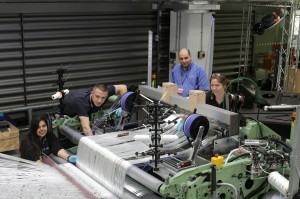
In the past, team members have been limited to using commercially available woven reinforcing materials but now, they will be able to design and weave their own material.
The new capability means the center will be able to further develop processes such as resin transfer moulding, where components are made by injecting resin into a mould into which dry fiber has been laid down.
‘Resin transfer moulding (RTM) is a bit of a “dark art”,’ said the center’s Dr Jody Turner.
‘RTM is supposed to be a very rapid and highly production orientated process, but getting it right can involve trial and error. Sometimes the resin doesn’t penetrate all of the material and parts of the component are left completely dry, which makes it useless.
‘We plan to carry out research that will help us to understand more about what happens during RTM injection and why results can be so erratic.’
Resin flow
Composite Centre researchers have already been studying how resin flows through fabrics made from carbon fiber and found the resin flow through the fabric isn’t symmetrical, despite the weave pattern being perfectly symmetrical. They believe this may be a result of slightly differing yarn tensions within the fabric.
Now they plan to increase their knowledge by experimenting with different tensions for the warp and the weft.
“If we can control warp and weft tension we might be able to influence resin flow,” said Dr Turner. “We also want to push the machine to the limit of its capabilities. For example, it isn’t designed to produce three dimensional structures, but we are hoping to create structures like pockets and flaps.”
Honeycomb structure
If the researchers are successful, they could be able to weave materials that could be opened up to form a series of boxes or a honeycomb structure that would give the completed composite component additional strength.





